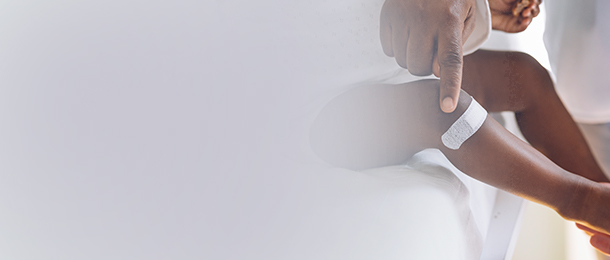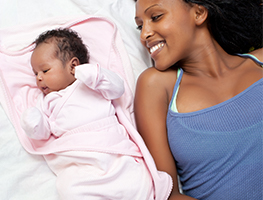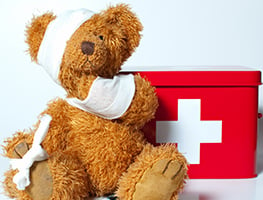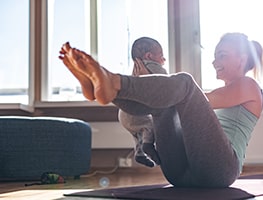|
Event and Recognition
|
First Aid
|
Actions
|
|
Unconscious person:
-
Is unaware of their surroundings and does not respond to sound
-
Makes no purposeful movements
-
Does not respond to questions or to touch
-
May or may not be breathing or have a pulse
|
-
To determine whether a person is unconscious or not, ask with a loud voice: “Are you okay?” If there is no response, tap on the chest or shoulder or gently shake the shoulders to see whether he responds and ask again. (If you suspect a head or neck injury, do not shake the shoulder). In the case of a baby, tap the feet.
-
Check the ABC: Airway, Breathing and Circulation. If the person is not breathing, start mouth-to-mouth breathing. If there is no pulse, start full CPR.
-
If choking is suspected, do the Heimlich manoeuvre.
-
If you do not suspect a head or spinal injury, move the person into the recovery position. This will prevent the airway from being blocked by the tongue, blood or vomit.
-
Look for a Medic-Alert tag that may explain the cause of the unconsciousness.
-
Look and treat for any obvious injuries, such as fractures or bleeding.
-
Keep the person warm. Do not give anything to eat or drink when the person awakes.
-
Monitor the level of response, breathing and pulse regularly until medical help arrives. Note: If a back or neck injury is suspected, do not move the person.
|
Call an ambulance:112 on a cellular phone; or 10177 for the National ambulance service; or
082 911 for Netcare; or
084 124 for ER24
|
Drowning
Breathing and heart may have stopped
|
The unconscious child:
-
Assess child’s condition and be prepared to resuscitate.
-
Place in the recovery position.
-
Remove any wet clothing.
-
Cover with a towel or blanket.
|
Note: Take the child to hospital even if they seem recovered, as any inhaled water may have caused lung damage.
|
|
Electrical Injury
-
May cause breathing and heart to stop
-
Burns where the current entered and left the body
-
Person may still be tightly gripping the cable
|
-
Don't approach the person who has been electrocuted until you're certain the area is safe.
-
Break contact between the person and the current source as quickly as possible: the best way to do this is to shut off the current at the main fuse box. Don't use the switch on the appliance. It is not recommended to use a wooden stick or similar to separate the person from the appliance: some power sources can arc up to 8 metres.
-
Check the ABCs (airway, breathing, circulation), start CPR if necessary and call an ambulance.
-
Check for signs of shock (A life-threatening condition, which occurs when blood flow is too low to serve the vital organs. Major burns cause loss of body fluids, which can lead to shock.)
-
With high voltages, the person may have been thrown into the air and may have sustained back, head or neck injuries. Internal body damage is not always obvious.
-
Cover any burnt area with a sterile gauze bandage or a clean cloth.
|
-
If the child seems unharmed, make them rest and observe their condition.
-
Seek medical advice.
-
Continue to monitor their condition and be prepared to resuscitate.
-
Cool any burns with cool water.
|
|
Head Injuries
The brain may be “shaken” by a violent blow causing concussion.
Recognising concussion:
-
Brief loss of consciousness, dizziness or nausea on recovery
-
Loss of memory of immediately preceding events
-
A mild headache
|
The Conscious Child:
Child who regains consciousness quickly:
-
If your child has been “knocked out”, even briefly, call a doctor and seek medical advice.
-
Make the child rest and watch them closely. If they have not recovered completely within 30 minutes, call an ambulance.
The Unconscious Child:
|
If unconscious call an ambulance.
|
|
Shock
Recognising shock:
-
Pale, cold and sweaty skin, tinged with grey
-
A rapid pulse becoming weaker
-
Shallow, fast breathing
Later signs include:
Note: The most likely cause of shock in a child is serious bleeding or a severe burn or scald.
|
-
Lay the child down flat, keeping the head lower than the chest.
-
Call an ambulance.
-
Raise legs, on pillows, to higher than the heart level.
-
Loosen any tight-fitting clothing.
-
Give constant reassurance. Encourage the child to talk or answer questions.
-
Cover with a light blanket to keep warm and observe breathing rate and skin colour.
-
Keep monitoring the pulse rate.
-
Be prepared to resuscitate.
|
Call an ambulance
|
























